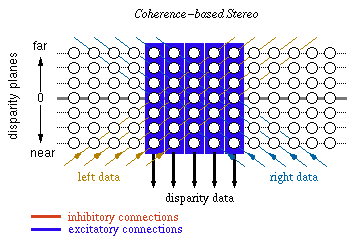Classical Cooperative Schemes
In the context of feature-based stereovision algorithms, cooperative schemes
were developed to find a reasonable solution to the ill-conditioned matching
problem of these type of algorithms. Feature-based stereo algorithms have
the following two problems:
- Disparities can only be estimated where features are present. For all
other image areas, values have to be interpolated by some heuristic. The
sparseness of stable features makes the estimation of dense disparity maps
difficult.
- Any feature detected in the left image can potentially be matched
with every feature of the same class in the right image. The number
of possible matches explodes as the feature-density increases.
Cooperative schemes implement in their network dynamics an error-measure
which is based on two assumptions, first formulated by D. Marr and T. Poggio
in 1976:
- Uniqueness: in a fixed view-direction, you can see only one
object. Clearly, this is not always true. A simple example are transparent
objects. Anyway, this translates into allowing only one match along
each view-direction. In cooperative schemes, network states with such a
property can be facilitated by introducing inhibitory interactions among
all disparity detectors responding to the same view-direction.
- Continuity: object surfaces are continuous - most of the time.
Therefore, the distance of objects varies smoothly with viewing direction,
except at object borders. This means that neighboring matches should
have similar disparity values. One can favor such configurations if one
introduces spatial facilitation between neighboring units.
Constraints like these define in conjunction with the raw matches a
complicated error-measure which is minimized through cooperative network
dynamics. Clearly, this process is iterative and therefore slow. Some of the
more common cooperative schemes are described below; in all the displays,
image data is fed diagonally into the network composed of horizontal
disparity layers. Due to this layout, different different depth planes are
stacked vertically above each other.
Overview of Cooperative Schemes

|
Two of the earliest cooperative schemes which were proposed as a basis
for stereo vision were the schemes developed by Dev, 1975, and Nelson, 1975.
Each disparity unit was supposed to have excitatory connections with its
spatial neighbors. Units at the same horizontal position but tuned to
different depths were connected by inhibitory links.
|
|
The above schemes were criticized by Marr & Poggio in 1976 for failing
to provide a satisfactory algorithm; they switched the inhibitory lines to
lines running along the view-directions of the left and right eye, not the
depth coordinate. Their algorithm could be shown to solve random-dot
stereograms successfully.
|

|

|
Earlier, Sperling had proposed a model without direct spatial
facilitation. The spatial spread of inhibitory connections in his model
leads to an indirect spatial facilitation by increasing the inhibition at
neighboring spatial positions.
|
|
In 1985, Prazdny criticized the introduction of inhibition along the
direction of the depth coordinate. He realized that this would rule out the
perception of transparency. His computational model used only spatial
facilitation, but with spreading somewhat in depth. This leads, along an argument
similar to Sperling, to an indirect inhibition in the depth direction.
|

|

|
One of the most evolved network implementations so far is the one by Pollard,
Mayhew & Frisby, 1985. This scheme uses a variety of rules to sort out invalid
matches. In addition, disparity units interact along cone-shaped regions.
This is very similar in spirit to a combination of the approaches of Sperling and Prazdny.
|
Evenso coherence-based stereo is not a feature-based
stereo algorithm, the network structure used for coherence-based stereo
looks very similar to the network structures described above.

The link structure which is used in coherence-based stereo turns out to
be more or less the inverse of the concepts utilized in traditional
cooperative approaches: no spatial facilitation is taking place, and
interaction occurs only in the direction of the depth axis. These links are
excitatory, not inhibitory.
Units used in classical cooperative schemes are basically units marking
the possibility or non-possibility of a match at that position (i.e. they are
binary units).
Coherence-based stereo uses disparity units which supply a disparity
estimate, i.e., they code a real number. This disparity estimate
might be correct or wrong; it is the purpose of the coherence-detection to
sort out the correct ones.
Comments are welcome!
© 1997 by Rolf Henkel - all rights reserved.
|


